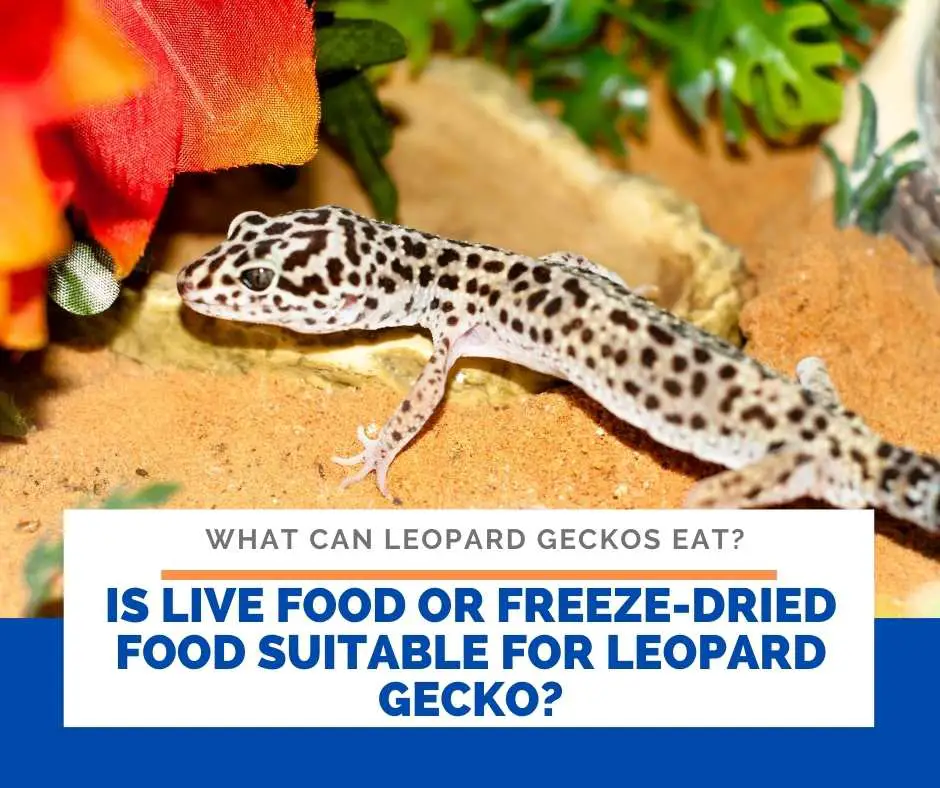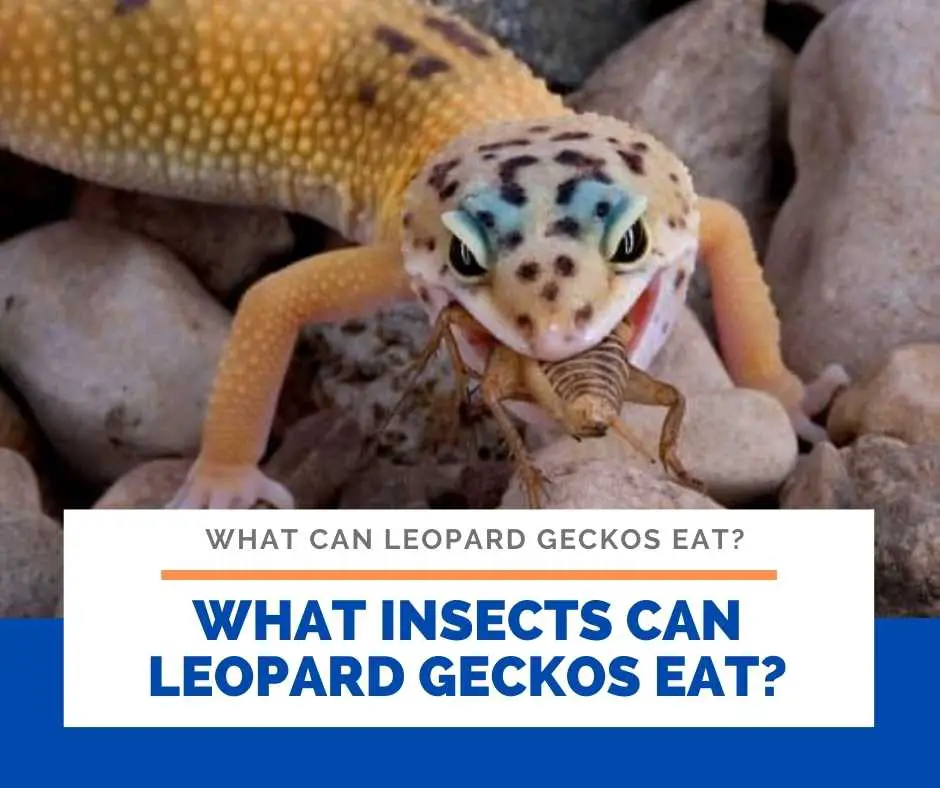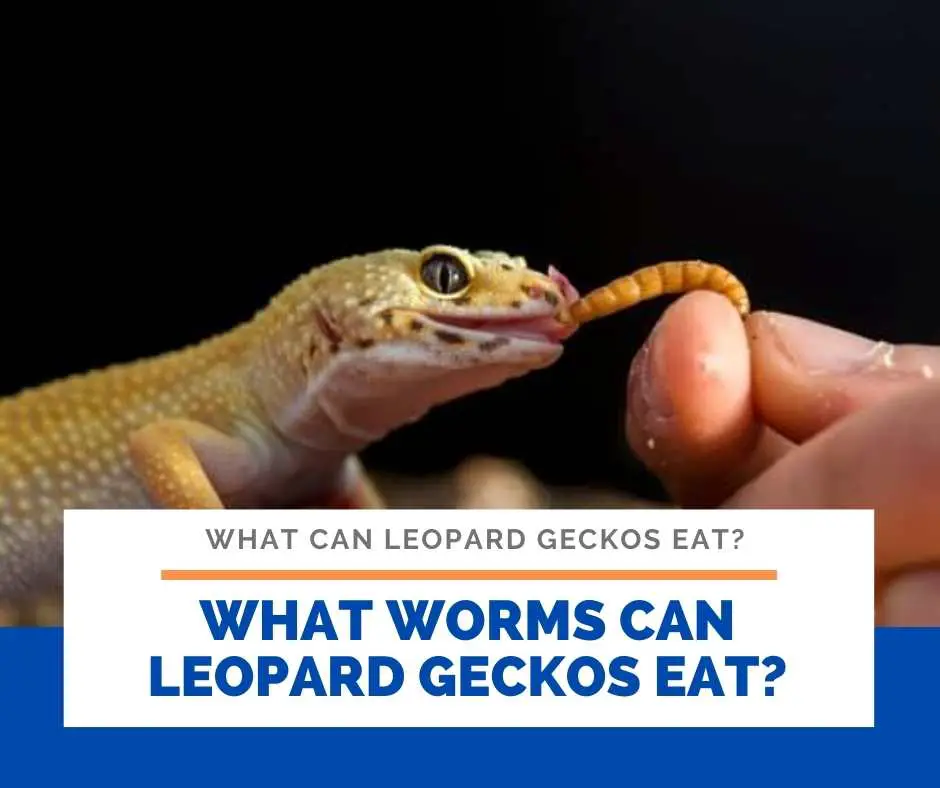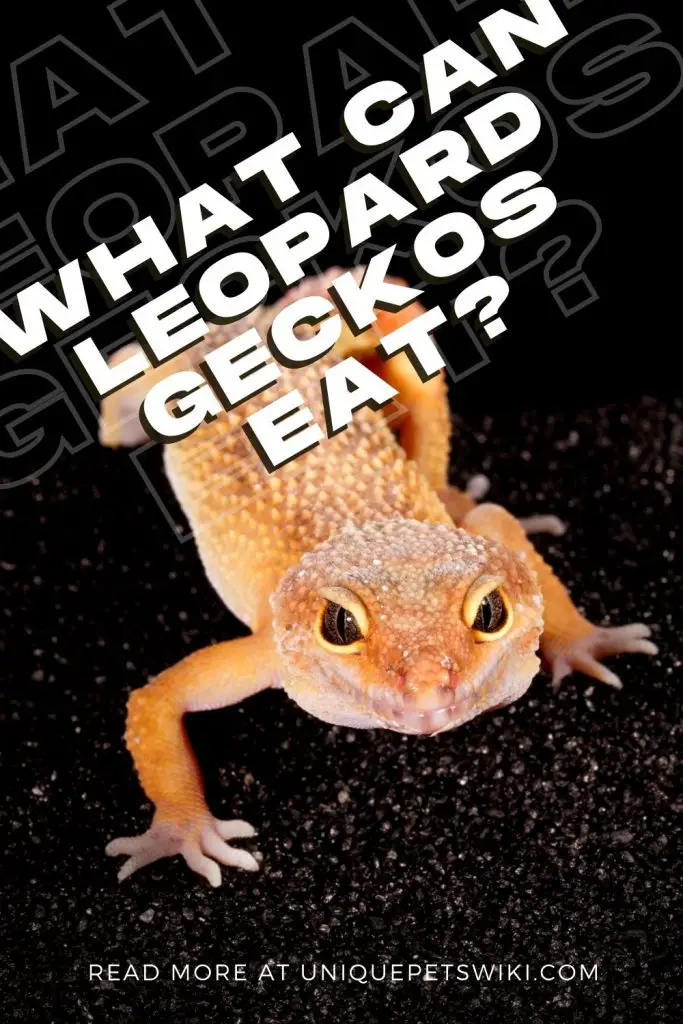Leopard geckos are insectivorous reptiles that will feed mainly on insects. There is a wide range of food options that you can serve your gecko. As a hobbyist, you need to know the ideal leopard gecko food to serve your leopard geckos as a meal.
This is because they will eat anything that moves in front of them. However, it is not all insects that are safe for leopard geckos. Leopard geckos also have to change eating habits as they grow up, and you should not be surprised if they eat crickets today, and next week, they are not eating.
In this article, you will get an insight into everything about leopard gecko’s diet, the suitable insect sizes, how often you can feed them, the best time to feed your geckos, and so on.
Contents
- What Can Leopard Geckos Eat?
- Is Live Food or Freeze-Dried Food Suitable For Leopard Gecko?
- Which Water And Food Dish To Buy For Your Leopard Gecko?
- How To Feed Leopard Gecko?
- What Size Insects For Leopard Gecko Feeding?
- What Insects Can Leopard Geckos Eat?
- What Worms Can Leopard Geckos Eat?
- What Insects Leopard Geckos Cannot Eat?
- What Fruits Can Leopard Geckos Eat?
- Can Leopard Geckos Eat Plants?
- Wrapping Up
What Can Leopard Geckos Eat?

Leopard geckos are carnivorous reptiles that will eat insects and small animals for their survival. You can feed leopard geckos with flies, beetles, mealworms, crickets, grasshoppers, small locusts, snails, silkworms, etc.
Diet is important in leopard gecko’s health, and you need to be careful about their eating habits. Leopard geckos feed on live animals, which means they will not eat any dead roach or dead or silent cricket.
You will need to feed adult leopard geckos with the right sized insects every other day. While baby leopard geckos and juveniles should be fed daily for proper nutrition as they grow. However, you can skip a day at least once a week to wean juvenile geckos into every other day schedule like adult geckos.
As a responsible hobbyist, ensure there is a regular supplier of leopard geckos food before buying one.
Is Live Food or Freeze-Dried Food Suitable For Leopard Gecko?

You can successfully raise your leopard geckos with both live insect and occasional preserved insect diet. Furthermore, feeding leopard geckos with live food helps make them active, encourages them to hunt, and increases their attention.
This means you should prioritize live food as it makes them engaged and happy. You can offer live food to your gecko at least every other day. However, if you train your leopard geckos with preserved foods from an early age, you can occasionally give them live food.
Furthermore, if your leopard geckos are already an adult before introducing freeze-dried insects, it can refuse to eat them. You will then need to wiggle the food artificially for engaging your leopard gecko to eat them.
Since it may not be possible to feed your gecko with live foods, you may need to move them with feeding tongs to make your gecko react to the food when feeding with dried insects. You will also need to dust dried insects with calcium and other supplements before feeding your gecko.
Which Water And Food Dish To Buy For Your Leopard Gecko?

Food and water dishes are among the major accessories that your gecko will need. You need to look for water and food bowls that are shallow so that your gecko will not have a problem reaching the water and food.
You can provide your gecko with four bowls. You can provide a shallow bowl for dried insects like crickets while another bowl can be high-sided for live insects like roaches, crickets, etc. This bowl will help to ensure your live insect does not escape or cause any infestation.
The third dish can be used as a water dish, while the fourth bowl can be used for pure calcium sources like grated cuttlebone. Furthermore, ensure that there is always water in your leopard gecko’s tank. You can also mist and spray your leopard gecko as another source of drinking water.
How To Feed Leopard Gecko?
You need to feed your leopard geckos with insects that are coated with calcium supplements in their feeding dish. An insect that is not gut-loaded and dusted has little or no nutritional value and can cause nutrient deficiencies.
This is why you should only offer gut-loaded and powdered insects to your gecko. Furthermore, you need to ensure your gecko feeding dish is tall enough to prevent insects from escaping. However, whenever an insect escapes, always ensure that you catch them and powder them again.
What Size Insects For Leopard Gecko Feeding?

Always ensure that you feed your leopard gecko with insects that are not larger than the space between their eyes. This is because your gecko can get impacted if the insects are too large. Here is a breakdown of insect size that you can give your gecko based on their age.
Hatchlings
You can feed them with 3/8 inches crickets or roaches. They may also take small mealworms.
Juvenile
You can feed them with ¼ inches crickets or roaches. They can take small to medium mealworms.
Adult
You can feed them with full-sized roaches, crickets, super worms, or large mealworms.
What Insects Can Leopard Geckos Eat?

Here are some insects that you can serve your leopard geckos.
Cricket
Crickets are among the popular and earliest feeders that you can get in the market. Many hobbyists opt for them because of the relative ease of getting them. Crickets contain acceptable levels of protein and fat suitable for your leopard geckos.
Leopard geckos also love cricket because of their jumping ability, which will attract even a lazy gecko.
Feeding routine
Hatchlings: You can feed hatchling leopard geckos with 2-week-old crickets every day.
Juveniles: You can feed juvenile leopard geckos with 3-week-old crickets every day.
Adults: You can feed adult leopard geckos with 4-week-old or large crickets every 3-4 days.
Dubia Roach
Dubia roaches are considered to be among the most nutritionally complete insects that you can feed your gecko. It is one of the best insects that you can get for your gecko due to their ease of care, hardiness, and it comes in different sizes for feeding your pets.
They are not expensive and do not make a noise like crickets. Furthermore, they cannot fly or climb out of a smooth surface. You will also love them as they cannot bite or harm your leopard geckos. Another thing is they are high in protein with low-fat content, which is suitable for the growth of your gecko.
Feeding routine
Hatchlings: Hatchling leopard geckos should be fed with ¼ inches of nymphs every day.
Juveniles: juvenile leopard geckos from one to three months old should be fed with 3/8 inches of dubia roach every day.
Geckos from four to eight months old should be fed with ½ inches of dubia roaches every other day.
Sub adults and adult geckos should be fed with ¾ to 1-inch dubia roaches.
Turkestan Red Runner Roaches
These roaches are among the most underrated food choices that you will find out there. They are about the same size as adult crickets but much better and hardier. They move really fast, and it acts as a perfect stimulant for your geckos.
The best thing is that they have high protein content with low chitin content, making it easier to digest them. They do not chirp or make noises like crickets and will not bite your gecko. However, you will need to offer them to your gecko in a food bowl as they can be hard to catch.
Turkestan red runner roaches are considered to be the ultimate prey item for geckos because they are always moving and will never play dead.
What Worms Can Leopard Geckos Eat?

Here are some worms that you can give to your leopard geckos.
Mealworms
Mealworms are popular worms used as a feeder for reptiles. These worms are rich in protein suitable for the growth of your gecko. It is among the easiest worms to breed, and the best thing is that they are odorless and easy to maintain.
Furthermore, it is best to dust them to add to the nutritional value they will provide your leopard geckos. The best thing about mealworms is that they cannot climb smooth surfaces, and you don’t have to worry that they will escape from the bowl.
They are also among the most inexpensive feeders that you can get in the market for your gecko.
Feeding Routine
Hatchling leopard geckos: You can feed them with mini to small-sized worms, about ¼ inches every day. Hatchlings geckos can eat about 8-12 worms per sitting.
Juvenile leopard geckos: You can feed them with small to medium-sized mediums worms from ¼ to ½ inches every day or every other day. Juvenile leopard geckos can eat about 12-16 mealworms in a sitting.
Subadult to adult leopard geckos: you can feed them with medium to large-sized mealworms from ¾ to 1 inch every 3-4 days. Adult leos can eat about 20-30 mealworms per sitting.
Note: You will need to feed as many mealworms that your gecko can eat in 5-10 minutes.
Tomato Hornworms
This is another amazing worm that you can use to feed your leopard gecko. The best thing is that they are quite large and you will use less of them for making a meal. They are also soft, which means your gecko can easily digest them.
You will also need to gut-load them before you give them to your leos.
Note: You can only use tomato hornworms to feed adult leopard gecko. You will also need to feed them to your gecko immediately when you receive them. Small tomato hornworms can be around 0.5 inches long but will quickly grow to approximately 3-4 inches long in two or more weeks.
However, you can keep them in a fridge to slow their growth rate.
Waxworms (As Treats)
Waxworms are a popular treat that you can give your leos. They usually have high-fat content, and they are good for providing an energy boost to breeding females. However, your gecko can become addicted to wax worms, and it is best to feed them with wax worms rarely.
If you decide to feed your gecko with wax worms, ensure that you do it once every 2-3 weeks. This means your gecko will not get addicted to them and will take other healthier insects that you provide.
ButterWorms (As Treats)
Although butter worms have more calcium and protein content that wax worms, they have around the same fat content. This is why it is best to give them to your leos only as a treat. They are also expensive because they are being imported.
If you decide to feed your gecko with wax worms, ensure that you do it once every 2-3 weeks. This means your gecko will not get addicted to them and will take other healthier insects that you provide.
Silkworms And Phoenix Worms
Silkworms and phoenix worms are also known as black soldier fly larvae and are perfect for your geckos.
Phoenix worms are rich in calcium and phosphorus levels, and you don’t even have to dust them. Phoenix worms also have low fat but excellent calcium to phosphorus ratio. However, you will need more phoenix worms to make a meal for your gecko because they are quite small.
Silkworms are the caterpillar of the silk moth. There are live and canned silkworms that you can buy for your leopard geckos. But they are more expensive than crickets, dubia roaches, mealworms, etc. You will also need to gut-load and dust them before giving your gecko.
Earthworms For Your Leopard Gecko
You can also feed your leopard geckos with earthworms. Earthworms contain a good level of calcium with low-fat content. All you need to do is ensure they are clean and do not contain dyes.
Before offering them to your leos, ensure you gut-load and dust them.
What Insects Leopard Geckos Cannot Eat?
Below are some insects that are unhealthy or toxic to leopard geckos. You need to avoid giving them to your geckos.
Lightning Bugs, Fireflies, Or Insects That Glows
Insects that can glow or light up in the dark should not be used to feed leopard geckos. This is because the chemical content used for glow is highly toxic to geckos, and even a gecko can have a lethal amount of toxins that will kill your gecko.
Furthermore, there is no known treatment, and your gecko may be dead before even getting to a vet.
Insects Caught Outside or In Your Home
Most of the insects in the market are raised in captivity, which means they are raised from a controlled environment and are parasite and disease-free. You should avoid feeding insects caught outside or in your home because they may carry diseases or toxins harmful to your gecko.
What Fruits Can Leopard Geckos Eat?

Leopard geckos can eat fruits if provided, but it is not beneficial to their body. This is why it is best to avoid feeding your gecko with fruits. However, if you plan to feed your gecko with fruit, ensure the fruit has high calcium and low phosphorus content.
Some of the fruits that you can feed your leos are peaches, apples, papayas, blackberries, mangoes, apricots, figs, cherries, melon, grapes, pears, etc.
Toxic Fruits For Leopard Geckos
Some fruits contain toxic chemicals that can be toxic to leopard geckos. Some of the fruits that you can avoid feeding your gecko are starfruit, rhubarb, and avocado.
Can Leopard Geckos Eat Plants?
Just like fruits, leopard geckos will eat plants if it is the only food available to them. However, plants have high sugar and acid content, which is not suitable for your geckos. This is why it is best to avoid feeding your geckos with vegetables.
Toxic Plants For Leopard Geckos
Because leopard geckos can eat anything in their terrarium when they are starving or need moistures. You need to avoid putting toxic plants in your gecko’s tank.
Some of the toxic plants and seeds to keep away are calla lilies, periwinkle, morning glories, English Ivy, peach pits, apple seeds, oak trees, Christmas cactus, apricot pits, pear seeds, etc.
Wrapping Up

Although choosing the right feeders for your gecko can be confusing with the various food alternatives available out there. However, offering a varied diet to your geckos can be more beneficial to your geckos’ health.
I hope that you find something helpful in this post and you can comment below if you have any questions.
